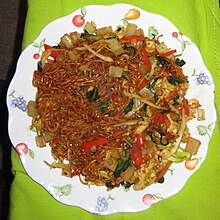 Bakmi topped with pork | |
| Alternative names | Bami, bakmie |
|---|---|
| Type | Noodle |
| Course | Main dish |
| Place of origin | Indonesia, derived from the Chinese noodle[1] |
| Region or state | Indonesia, Thailand, Singapore, Laos, Suriname, Belgium and the Netherlands |
| Serving temperature | hot |
| Main ingredients | Wheat flour, ground pork, soy sauce |

Bakmi (Javanese: ꦧꦏ꧀ꦩꦶ, romanized: bakmi) or bami (Thai: บะหมี่, pronounced [bā.mìː], Lao: ບະໝີ່, pronounced [bā.mīː]) is a type of wheat-based noodles derived from Chinese cooking tradition. It was brought to Indonesia[1] by Chinese immigrants from Southern Chinese provinces like Fujian. It is typically prepared seasoned in soy sauce and topped with pork products, which is often substituted for other protein sources in predominantly Muslim Indonesia. Chinese-style wheat noodles has become one of the most common noodle dishes, especially in Southeast Asian countries which have significant Chinese populations and known by various names.
Chinese-style wheat noodles is known as bakmi in Indonesia, where it has been adapted to more closely align with the local tastes and adapted in Javanese and Indo cuisine. Bakmi is between Chinese style wheat noodles and Japanese udons in thickness, and there are several variants of bakmi in Indonesia. The name bakmi literally translates to "meat noodle", where meat includes chicken and beef.
In Indonesia, especially in large urban areas such as Jakarta, Medan and Surabaya, there are many warung food stalls, restaurants and eateries that specialise in serving this type of noodle dish, each specialising in different ingredients and toppings.[2]
- ^ a b "Sejarah Bakmie Indonesia". (Indonesian)
- ^ Valentina, Jessicha (29 March 2019). "Jakpost guide to Tirta Lie's favorite 'bakmi' places". The Jakarta Post. Retrieved 2024-06-23.